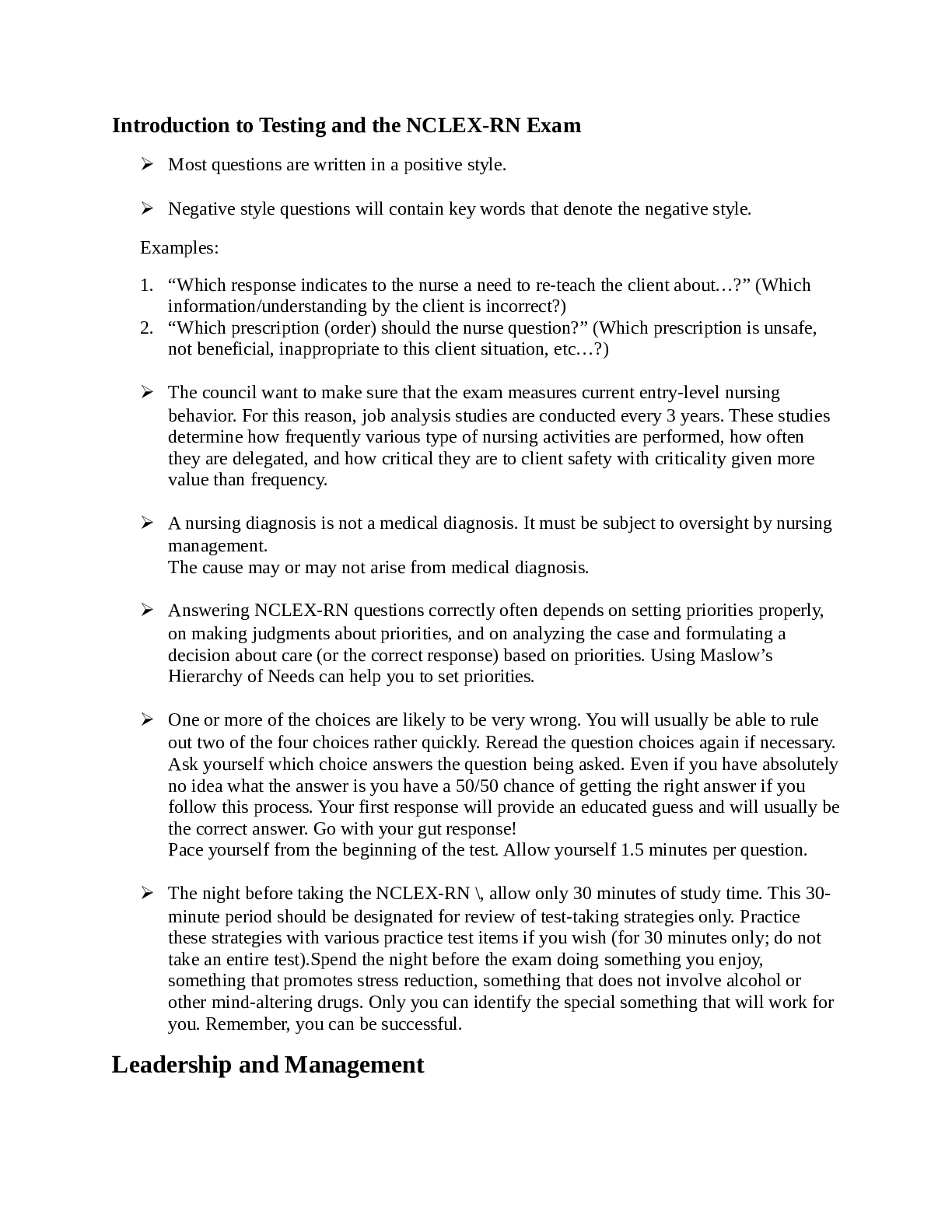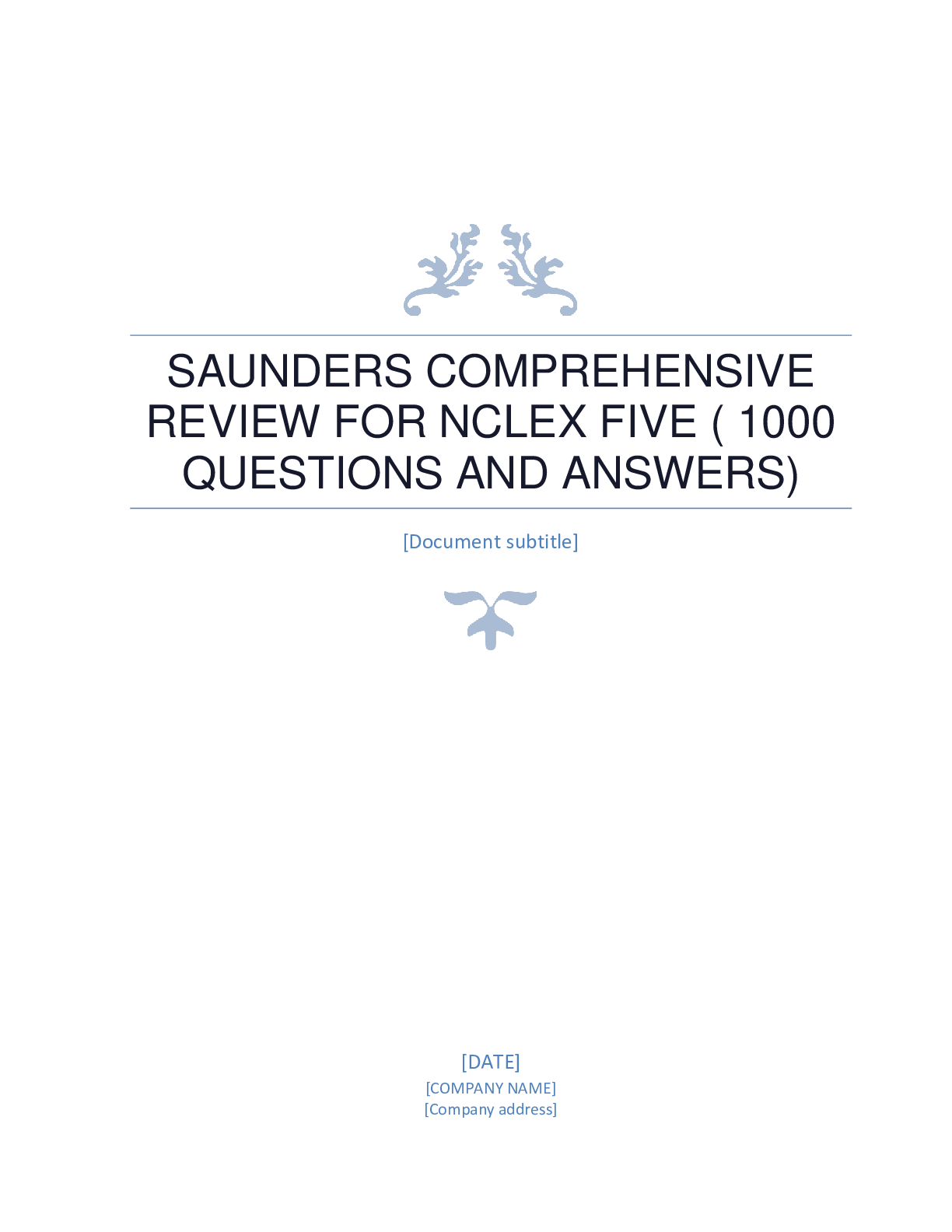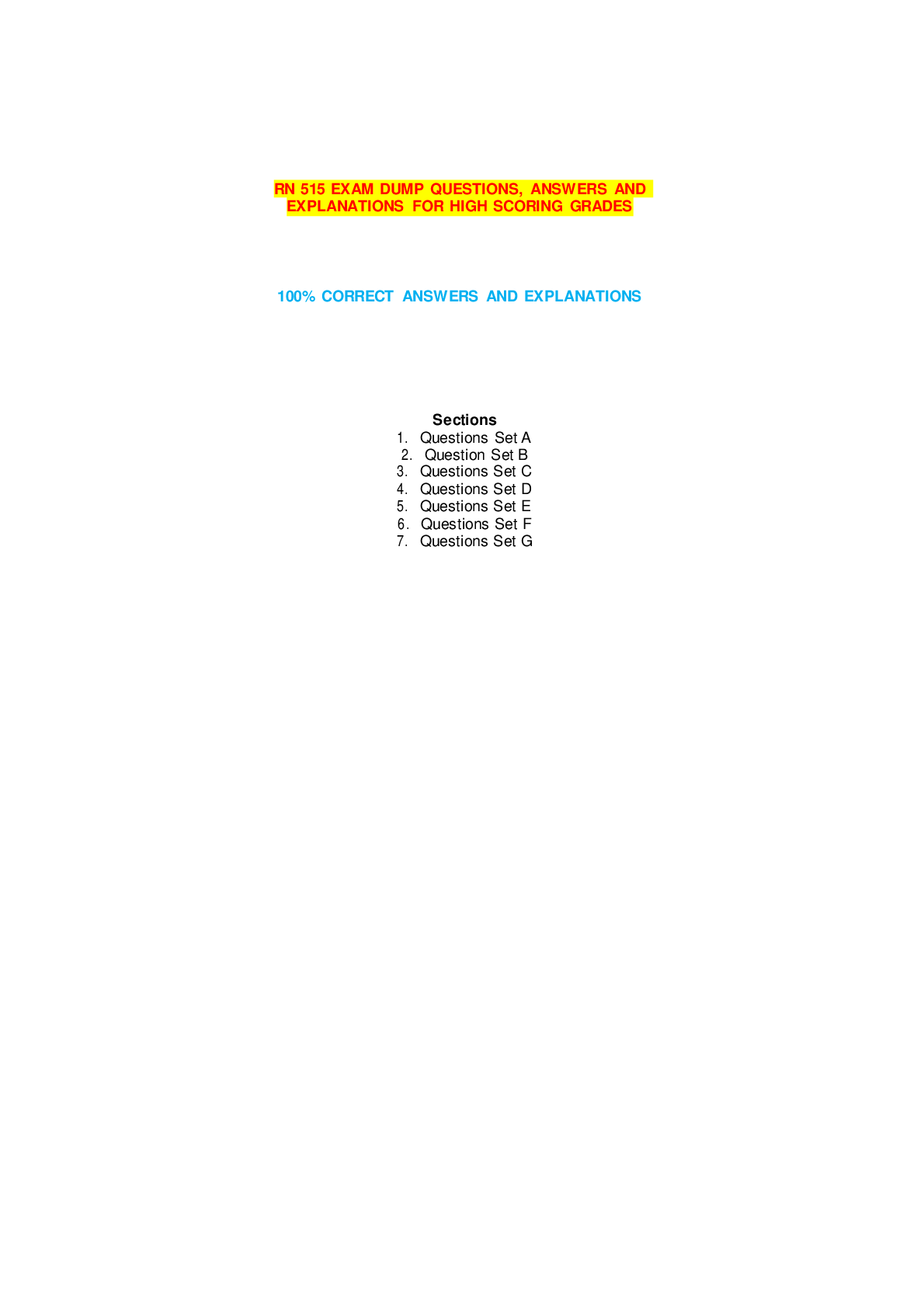Nclex Hints : Introduction to Testing and the NCLEX-RN Exam
Document Content and Description Below
Introduction to Testing and the NCLEX-RN Exam Most questions are written in a positive style. Negative style questions will contain key words that denote the negative style. Examples: 1. �... ��Which response indicates to the nurse a need to re-teach the client about…?” (Which information/understanding by the client is incorrect?) 2. “Which prescription (order) should the nurse question?” (Which prescription is unsafe, not beneficial, inappropriate to this client situation, etc…?) The council want to make sure that the exam measures current entry-level nursing behavior. For this reason, job analysis studies are conducted every 3 years. These studies determine how frequently various type of nursing activities are performed, how often they are delegated, and how critical they are to client safety with criticality given more value than frequency. A nursing diagnosis is not a medical diagnosis. It must be subject to oversight by nursing management. The cause may or may not arise from medical diagnosis. Answering NCLEX-RN questions correctly often depends on setting priorities properly, on making judgments about priorities, and on analyzing the case and formulating a decision about care (or the correct response) based on priorities. Using Maslow’s Hierarchy of Needs can help you to set priorities. One or more of the choices are likely to be very wrong. You will usually be able to rule out two of the four choices rather quickly. Reread the question choices again if necessary. Ask yourself which choice answers the question being asked. Even if you have absolutely no idea what the answer is you have a 50/50 chance of getting the right answer if you follow this process. Your first response will provide an educated guess and will usually be the correct answer. Go with your gut response! Pace yourself from the beginning of the test. Allow yourself 1.5 minutes per question. The night before taking the NCLEX-RN \, allow only 30 minutes of study time. This 30- minute period should be designated for review of test-taking strategies only. Practice these strategies with various practice test items if you wish (for 30 minutes only; do not take an entire test).Spend the night before the exam doing something you enjoy, something that promotes stress reduction, something that does not involve alcohol or other mind-altering drugs. Only you can identify the special something that will work for you. Remember, you can be successful. Leadership and Management Often an NCLEX-RN question asks who should explain a surgical procedure to the client. The answer is the provider. This is probably the only question in which you refer to the healthcare provider. Remember, nurses are proud people; nurses wrote the test items, and they expect nurses to handle most client situations. Also remember that it is the nurse’s responsibility to be sure that the operative permit is signed and is on the chart. It is not the nurse’s responsibility to explain the procedure to the client. Often questions are asked regarding the Good Samaritan Act, which is the means of protecting the nurse when he or she is performing emergency care. If the nurse carries out a health care provider’s or a physician’s prescription for which he or she is not prepared and does not inform the healthcare provider or physician of his or her lack of preparation, the nurse is solely liable for any damages. If the nurse informs the healthcare provider or physician of his or her lack of preparation in carrying out a prescription and carries out the prescription anyway, the nurse and the healthcare provider or physician are liable for any damages. Assignments are often tested on the NCLEX-RN. The Nurse Practice Acts of each state governs policies related to making assignments. Usually, when determining who should be assigned to do a sterile dressing change, for example, a licensed nurse should be chosen; that is an RN or licensed practical nurse (LPN) who has been checked off on this procedure. Restraints of any kind may constitute false imprisonment. Freedom from unlawful restraint is a basic human right and is protected by the law. Assertive communication starts with “I need” rather than “You must.” Motivation comes from within an individual. A nurse leader can provide an environment that will promote motivation through positive feedback, respect and seeking input. Look for responses that demonstrate these behaviors. Delegating to the right person requires that the nurse be aware of the qualifications of the delegatee: appropriate education, training, skills, experience and demonstrated and documented competence. (18) Remember the nursing process: assessments, analysis, diagnosis, planning and evaluation (any activity requiring nursing judgment) may not be delegated to UAP. Delegated activities fall within the implementation phase of the nursing process. (18) UAPs generally do not perform invasive or sterile procedures. (18) The RN is responsible for adhering to the three basic aspects of supervision when delegating to other healthcare personnel such as LPNs, graduate nurses, inexperienced nurses, students nurses and UAPs. (18) Priorities often center on which client should be assessed first by the nurse. Ask yourself: Which client is most critically ill? Which client is most likely to experience significant change in condition? Which client requires assessment by an RN? (18) The nurse manager must analyze all the desired outcomes involved when assigning rooms for clients or assigning client care responsibilities. A client with an infection should not be assigned to share a room with a surgical or immunocompromised client. A nurse’s client care management should be based on the nurse’s ability, the individual client’s needs, and the needs of the entire group of assigned clients. Safety and infection control are high priorities. (18) Change causes anxiety. An effective nurse change agent uses problem-solving skills to recognize factors such as anxiety that contribute to resistance to change and uses decision making and interpersonal skills to overcome that resistance. Interventions that demonstrate these skills include seeking input, showing respect, valuing opinions and building trust. (18) It is important to remember that in disaster and bioterrorism management, the nurse must consider both the individual and the community. (2) Advanced Clinical Concepts ARDS is an unexpected, catastrophic pulmonary complication occurring in a person with no previous pulmonary problems. The mortality rate is high (50%). (27) In ARDS, a common laboratory finding is a lowered PO2. However, these clients are not very responsive to high concentrations of oxygen and often require intubation and mechanical ventilation with positive end-expiratory pressure (PEEP). (27) Think about the physiology of the lungs by remembering “PEEP”: Positive endexpiratory pressure is the instillation and maintenance of small amounts of air into the alveolar sacs to prevent them from collapsing each time the client exhales. The amount of pressure can be set by the ventilator and is usually around 5 to 10 cm H2O. (27) Suction only when secretions are present.(27) Before drawing a sample for ABGs from the radial artery, perform the Allen test to assess collateral circulation. Make the client's hand blanch by obliterating both the radial and the ulnar pulses. Then release the pressure over the ulnar artery only. If flow through the ulnar artery is good, flushing will be seen immediately. The Allen test is then positive,and the radial artery can be used for puncture. If the Allen test is negative, repeat on the other arm. If this test is also negative, seek another site for arterial puncture. The Allen test ensures collateral circulation to the hand if thrombosis of the radial artery should follow the puncture. (28) - Pco2 >45 or Po2 <60 on 50% O2 signifies respiratory failure. -A child in severe distress should be on 100% O2. (28) Early signs of shock are agitation and restlessness resulting from cerebral hypoxia.(29) If cardiogenic shock exists in the presence of pulmonary edema (i.e., from pump failure), position client to reduce venous return (high Fowler position with legs down) to decrease further venous return to the left ventricle.(29) Severe shock leads to widespread cellular injury and impairs the integrity of the capillary membranes. Fluid and osmotic proteins seep into the extravascular spaces, further reducing cardiac output. A vicious circle of decreased perfusion to all cellular level activities ensues. All organs are damaged, and if perfusion problems persist, the damage can be permanent. (30) All vasopressor and vasodilator drugs are potent and dangerous and require that the client be weaned onto and off them. Do not change both infusion rates simultaneously.(31) A client is brought into the hospital suffering shock symptoms as a result of a bee sting. What is the first priority? Maintaining an open airway (the allergic reaction damages the lining of the airways, causing edema). Also, keep the client warm and free of constricting clothing; keep client's legs elevated (but not in the Trendelenburg position because the weight of the lower organs restricts breathing). Epinephrine: 1:1000, 0.2 to 0.5 ml subcutaneous for mild cases or Epinephrine: 1:10,000, 5 ml IV for severe cases Volume-expanding fluids are usually given to clients in shock. However, if the shock is cardiogenic, pulmonary edema may result. Drugs of choice for shock: •Digitalis preparations. They increase the contractility of the heart muscle. •Vasoconstrictors (Levophed, Dopamine). Generalized vasoconstriction provides more blood to the heart to help maintain cardiac output. (33) You are caring for a woman who was in a severe automobile accident several days earlier. She has several fractures and internal injuries. The exploratory laparotomy was successful in controlling the bleeding. However, today you find that this client is bleeding from her incision, is short of breath, and has a weak, thready pulse, cold and clammy skin, and hematuria. What do you think is wrong with the client, and what would you expect to do about it? These are typical signs and symptoms of DIC crisis. Expect to administer IV heparin to block the formation of thrombin (Coumadin does not do this). However, the client described is already past the coagulation phase and into the hemorrhagic phase. Her care would include administration of clotting factors, along with palliative treatment of the symptoms as they arise. (Her prognosis is poor.) (34) NCLEX-RN® questions on cardiopulmonary resuscitation (CPR) often deal with prioritization of actions. Question: What actions are required for each of the following situations? • A 24-year-old motorcycle accident victim with a ruptured artery of the leg who is pulseless and apneic • A 36-year-old first-time pregnant woman who arrests during labor • A 17-year-old with no pulse or respirations who is trapped in an overturned car that is starting to burn • A 40-year-old businessman who arrests 2 days after a cervical laminectomy (35) When to seek emergency medical services (EMS): •The symptoms of anterior myocardial infarction (AMI) characteristically last more than 15 minutes and are more intense than angina. •The American Heart Association's guidelines recommend that those at risk for acute coronary syndrome (ACS) should activate the EMS system if chest discomfort worsens or is unimproved 5 minutes after taking one tablet or spray of nitroglycerin.(35) It is important for the nurse to stay current with the American Heart Association's guidelines for basic life support (BLS) by being certified every 2 years, as required. (35) CPR is performed at a 30:2 ratio of compression to ventilations, at the compression rate of 100/min, continuously without pauses for ventilation. After five cycles, reassess for breathing and pulse. The compressor role should be rotated about every 2 minutes without interruption of the compression rate. (36) At 20 weeks' gestation and beyond, the gravid uterus should be shifted to the left by placing the woman in a 15- to 30-degree angled left lateral position or by using a wedge under her right side to tilt her to her left.(36) Initiate CPR with BLS guidelines immediately: then move on to advanced cardiac life support (ACLS) guidelines. (36) When significant arterial acidosis is noted, try to reduce Pco2 by increasing ventilation, which will correct arterial, venous, and tissue acidosis. Bicarbonate may exacerbate acidosis by producing CO2. ACLS guidelines have recommended that bicarbonate not be used unless hyperkalemia, tricyclic antidepressant overdose, or preexisting metabolic acidosis is documented.(36) In the pulseless arrest algorithm (PALS), the search for and treatment of possible contributing factors should include checking for hypovolemia, hypoxia, hydrogen ion acidosis, hypokalemia and hyperkalemia, hypoglycemia, hypothermia, toxins, tamponade (cardiac), tension pneumothorax, thrombosis (cardiac, pulmonary), and trauma.(37) Changes in osmolarity cause shifts in fluid. The osmolarity of the extracellular fluid (ECF) is almost entirely due to sodium. The osmolarity of intracellular fluid (ICF) is related to many particles, with potassium being the primary electrolyte. The pressures in the ECF and the ICF are almost identical. If either ECF or ICF changes in concentration, fluid shifts from the area of lesser concentration to the area of greater concentration. (38) •Dextrose 10% is a hypertonic solution and should be administered IV. •Normal saline is an isotonic solution and is used for irrigations, such as bladder irrigations or IV flush lines with intermittent IV medication. •Use only isotonic (neutral) solutions in irrigations, infusions, etc., unless the specific aim is to shift fluid to intracellular or extracellular spaces. (38) Potassium imbalances are potentially life-threatening; they must be corrected immediately. A low magnesium level often accompanies a low K+, especially with the use of diuretics.(38) FLUID VOLUME DEFICIT: DEHYDRATION •Elevated blood urea nitrogen (BUN): The BUN measures the amount of urea nitrogen in the blood. Urea is formed in the liver as the end product of protein metabolism. The BUN is directly related to the metabolic function of the liver and the excretory function of the kidneys. •Creatinine, as with BUN, is excreted entirely by the kidneys and is therefore directly proportional to renal excretory function. However, unlike BUN, the creatinine level is affected very little by dehydration, malnutrition, or hepatic function. The daily production of creatinine depends on muscle mass, which fluctuates very little. Therefore, it is a better test of renal function than is theBUN. Creatinine is generally used in conjunction with the BUN test, and they are normally in a 1:20 ratio. •Serum osmolality measures the concentration of particles in a solution. It refers to the fact that the same amount of solute is present, but the amount of solvent (fluid) is decreased. Therefore, the blood can be considered “more concentrated.” •Urine osmolality and specific gravity increase. (39) Check the IV tubing container to determine the drip factor because the drip factors vary. The most common drip factors are 10, 12, 15 and 60 drops per milliliter. A microdrip is 60 drops per milliliter. (42) Flushing a saline lock efficiently requires approximately 1½ times the amount of fluid the tubing will hold. Remember to use sterile technique to prevent complications, such as infiltration, emboli, and infection. (430 The acronym ROME can help you remember: respiratory, opposite, metabolic, equal. (45) Review the order of blood flow through the heart: Unoxygenated blood flows from the superior and inferior vena cava into the right atrium, then to the right ventricle. It flows out of the heart through the pulmonary artery, to the lungs for oxygenation. The pulmonary vein delivers oxygenated blood back to the left atrium, then to the left ventricle (largest, strongest chamber), and out the aorta. Review the three structures that control the one-way flow of blood through the heart: Valves Atrioventricular valves • Tricuspid (right side) • Mitral (left side) Semilunar valves • Pulmonic (in pulmonary artery) • Aortic (in aorta) Chordae tendinae Papillary muscles (46) [Show More]
Last updated: 1 year ago
Preview 1 out of 77 pages
Instant download

Buy this document to get the full access instantly
Instant Download Access after purchase
Add to cartInstant download
Also available in bundle (1)

NCLEX-RN
NCLEX-RN
By Muchiri 3 years ago
$20
4
Reviews( 0 )
Document information
Connected school, study & course
About the document
Uploaded On
Apr 21, 2021
Number of pages
77
Written in
Additional information
This document has been written for:
Uploaded
Apr 21, 2021
Downloads
1
Views
66
















